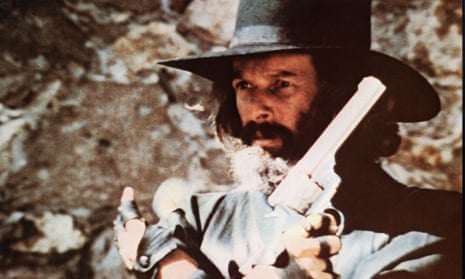Now 90 and still a vigorously engaged public figure, the midnight-movie magus, comic-book artist and tarot enthusiast Alejandro Jodorowsky has become the touchstone for a certain kind of untamed cinema, the last survivor-practitioner of underground freaky radicalism, standing up to corporate blandness with his countercultural film-making. A remarkable late-flowering of creativity recently brought us his highly personal films The Dance of Reality (2013) and Endless Poetry (2016). Now we can see his 1970 breakthrough, El Topo (The Mole), which is on rerelease.
Influenced by Sergio Leone, Tod Browning, Luis Buñuel and (worryingly) Charles Manson, it’s a bizarre head-trip festival of occult psychedelia, heatstroke visuals, Age-of-Aquarius nude dancing and violence through poster-paint fake blood splattered about the place. After seeing El Topo in 1970, Jodorowsky superfan John Lennon famously promoted and yet also stymied this film-maker’s career, encouraging his manager Allen Klein to invest in Jodorowsky’s future productions, an involvement that bogged the director down in legal and commercial wrangling and did much to cause the effective disappearance, which fed into his mythic reputation.
Jodorowsky stars as the black-clad horseman, riding through a stark western desert with a small, naked boy riding behind him: his son, played by his actual son, Brontis, who was to make an appearance in much of the great man’s subsequent work and whose presence here underlines the film’s Freudian theme of self-actualisation through parricide. The rider and his boy have a horrifying encounter with the aftermath of a cult slaying, and then, through his sexual experience with a mysterious woman, the rider embarks on a mission in the wilderness like Jesus or Moses, vowing to travel through the desert, taking on four bandit gunmen. He then abandons his boy to Franciscan monks and, after renouncing violence, is carried off by mutants to a cave from which he must, mole-like, tunnel out, finally to face his now-grownup son.
After 50 years, El Topo does not stand up quite as well to its original legendary status. It is perhaps a little too infatuated with violence and grotesquerie, and, unlike Leone, Jodorowsky sometimes gives the impression that he doesn’t really believe in the ideas of good or bad or ugly, and these ideas – as well as any character in El Topo – are just tarot cards to be reshuffled and dealt in any order, although there is a fascination in the very opaque quality of that symbolism. His evocation of the desert is fascinating, as a blank canvas to showcase bizarre dreamlike figures of the mind: Ciro Guerra’s Birds of Passage is, I think, indebted to El Topo.
The Mansonesque cult horror scenes are what locate El Topo in its era: the jaded, paranoid fag-end of the 60s, with pleasure and love coagulating into violence and machismo. These are still disturbing moments, especially that bizarre crucified goat, and it’s hilarious (but also unhilarious and cruel) to see that genuinely dangerous non-CGI lion pacing and turning in the background of one shot, clearly being wrangled by someone off-screen to the right.
And what does it all mean? In so much as it means anything, it is about that circular, spiralling journey that El Topo said he would have to take through the desert to find all four of the gunmen he would need to conquer. In his end is his beginning, and his son’s beginning. Best viewed at midnight.

Comments (…)
Sign in or create your Guardian account to join the discussion